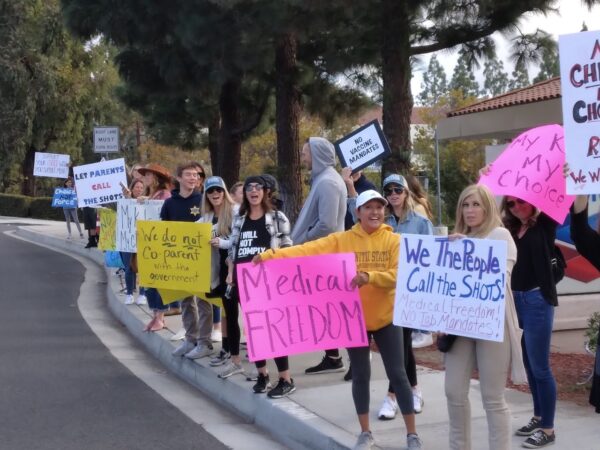Bethany Blankley | The Center Square contributor


(The Center Square) – Schools throughout the country are experiencing teacher shortages due to several factors. In some states, legislatures have responded by lowering substitute teaching standards. In others, schools are calling on parents to fill the gap or are simply closing schools because they don’t have enough staff.
School choice advocates say it’s time to start funding students instead of government-run public school systems.
Nationwide, according to Burbio.com‘s school closure tracker, 7,164 schools were “actively disrupted (not offering in-person learning) on one or more days during the week beginning January 10th.” Accompanying the tracker is a map, which shows which schools nationwide are closed or are providing no in-person instruction by day and week. The site, an industry leader in aggregating school, government, library and community information, tracks school closures and mask policies.
The Richardson Independent School District, farther north in the Dallas metro area, has also asked parents to fill in to meet “immediate and critical shortages.” Parents have been asked to volunteer in a range of positions despite paying the district more in increased school taxes. Richardson ISD increased its tax rate by 2.41% for maintenance and operations. The school district is asking parents to volunteer as cafeteria monitors, central office assistants or substitute teachers.
In California, Palo Alto Unified School District’s superintendent posted a video asking for volunteers so that the district’s schools could stay open.
“We can’t keep up. There’s no labor pool,” Superintendent Don Austin told parents. “No amount of money can solve this issue. We need your help.”
Since the beginning of the current academic year, many Michigan schools closed because of staff shortages. To provide a temporary solution, the state legislature passed a bill, which Democratic Gov. Gretchen Whitmer signed Dec. 23.
The new law allows any previously vetted school district employee with a high school diploma to substitute teach: including bus drivers, janitors, cafeteria workers, library aides, secretaries, and others. The law sunsets at the end of the current school year.
The legislatures of Iowa and Missouri also passed laws lowering education requirements for substitute teachers, the National Council of Teacher Quality reported.
As taxes go up, choices decline, and students suffer academically and emotionally, Corey DeAngelis, National Director of Research at the American Federation for Children, says these are all examples of the flawed approach of funding school systems instead of students.
“School closures have hurt children academically, mentally, and physically,” he told The Center Square. “Two weeks to slow the spread has turned into two years to flatten a generation. Public schools spend over $15,000 per student per year, on average. It’s time to give that money directly to families so they can find alternatives. We should fund students, not systems.”
He also advocates that parents should be given money directly to educate their children in a school of their choice.
“The system is broken beyond repair,” DeAngelis said.
Public school staffing shortages have been going on for some time nationwide.
According to a 2021 Frontline Education survey of 1,200 school district administrators and principals, 67% reported a shortage of substitute teachers. Two-thirds reported teacher shortages, a record high since the survey was first launched in 2015.
“Teacher shortages are most common in urban school systems, with 75% of districts in cities of any size reporting shortages,” the report states; 65% of rural districts reported shortages, as did 60% of suburban districts.
A 2020 EdWeek Research Center survey found that nearly three-quarters of school and district leaders said their need for substitute teachers was up, but applications were down. As a result, one-third of those surveyed said they could fill 50% or fewer of their absent teachers’ classes with substitutes; 80% said they left at least some classes uncovered.
This number is only expected to go up, the Texas Homeschool Coalition, argues. The group saw a 400% increase in requests from parents to help them process withdrawal requests from public schools in 2020; in 2021, the number was five times greater.
By the end of the school year, more than 750,000 students were being home-schooled in Texas, more than all private and charter school students combined, the coalition notes. It also estimates that Texas home-school families save the state more than $7 billion a year.
Nationally, a plurality of parents who chose other options, 34%, said they primarily withdrew their children because of concerns related to the school environment; 21% to provide moral or religious instruction; 17% because they were dissatisfied with the school’s academic instruction.
According to a RealClear Opinion Research poll last year, 40% of registered voters said they were more likely to home-school after their state’s respective lockdowns ended.
While John Schilling, president of the American Federation of Children, said at the time of national school lockdowns that “policymakers owe it to the taxpayers who are footing the $800 billion K-12 education bill to maximize their investment by ensuring every child has access to a quality education and outcomes are improved across the board.”
A year later, policy makers are asking parents to step in to fill the gap left by teachers and staffing shortages. And parents are still fighting legal battles with their local school boards and governments over a range of issues, including potentially being labeled as domestic terrorists by the U.S. Department of Justice.
Source: The Center Square
Visit the The Center Square
Get Citizensjournal.us Headlines free SUBSCRIPTION. Keep us publishing – DONATE



